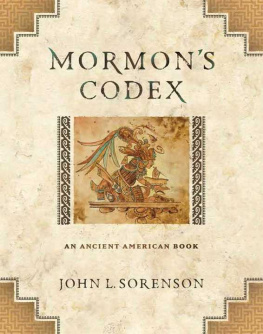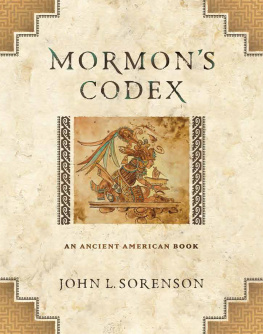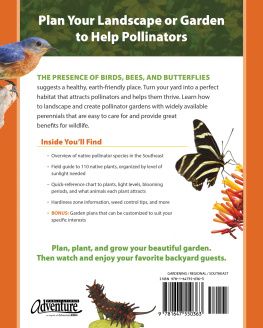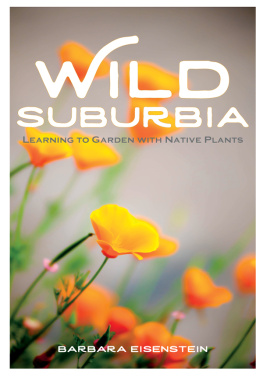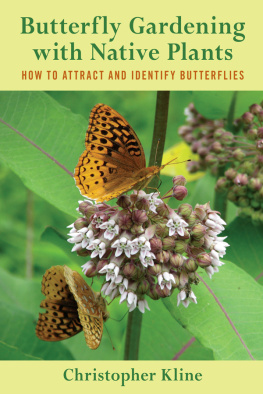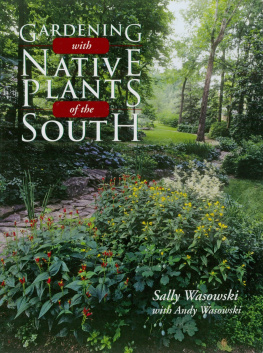Acknowledgments
No one puts together a reference book like this without guidance and support. Because the subject matter ranges from wildlife biology to botany to ornithology and from landscaping to gardening to restoration, the knowledge of many supersedes the knowledge of one. So all of the folks who generously offered their time and expertise have made this work possible, including the following:
Paul Bouseman, Botanical Curator, Mesker Park Zoo and Botanic Garden, pursues his lifelong interest in native plants at his familys redeveloped farm-stead. I owe him far more than I can ever repay, both for his friendship and his mentoring. His personal experience with thousands of plant species gives him unparalleled understanding of their behaviors and attributes. Genius in his suggestions for addressing potentially controversial matters, he showed me how to smooth the way for gently introducing readers to a complicated subject. From the books initial plan and continuing to its completion, his wisdom is reflected throughout much of this effort. The stars in his crown must now surely be blind ingly bright. Thank you, Paul, for your kindness, generosity, and devotion to the plant worldand to this project.
My hat is off to botanist Ellen Jacquart, retired Stewardship Director of The Nature Conservancy of Indiana and chair of the Invasive Plant Education Committee of the Indiana Native Plant and Wildflower Society. Years ago (we wont say how many, Ellen), her educational workshops gave me the initial nudge to plant natives to attract birds to my yard; and now, having critiqued the manuscript, she has kept me in line, returning me to the straight and narrow when I veered from accuracy. She corrected errors I would never have recognized and taught me along the way. Further, her encouragement regarding the need for this work lends credibility to the effort. Thank you, Ellen, for your gracious and far-reaching contributions. Any errors that remain are mine.
A gracious thank-you to Heath Hamilton, Wildlife Refuge Specialist with the United States Fish and Wildlife Service, currently focusing on restoration efforts at Patoka River National Wildlife Refuge and Management Area. He read the manuscript, offered encouragement, and recommended valuable additions and alterations. Since he also manages his own five-acre home refuge, planted in prairie, woodland, and pond edge and landscaped almost entirely with natives, Im grateful for his tour around the propertyan intense two-hour in-the-field education, identifying plants, their growing habits, and the wildlife they attract. The experience was an inspirational springboard into manuscript revisions. Thank you, Heath.
A kind and heartfelt note of thanks to Robin Wright Mallery, passionate and self-described as needs-to-learn-more landscaper for the birds. She, too, read the manuscript with an eye (and ear) for this books likely audience. Her encouragement helped me keep on keeping on, completing the rewrites in timely fashion.
A true friend, F. Jeanette Frazier, retired Indiana Accredited Horticulturist, earns my sincere gratitude for focusing her keen eye for detail on the initial manuscript, significantly aiding in the goal toward accuracy. She gave up precious time to talk me through a maze or two.
Cassie Janzen Hall, Director of Philanthropy for The Nature Conservancy and home native landscaper for the birds, also read with a critical eye for detail. Thanks to her for proofreading during a time of personal stress. Im not sure which of us needed the other more at the time.
There were innumerable conversations with folks about those little technical details that, inaccurately presented, would have made the work less credible. While Ive bent the ears of many, a few deserve special thanks for tolerating my endless questions:
Nancy Hasting, Purdue University grad horticulturalist and now owner and operator of Hasting Plants, explained the ins and outs and overall complications of plant labelswhat they mean, what they dont mean, what they say, and for good measure, what they should say but dont. Thanks, Nancy, for helping me understand.
Entomologist John A. Shuey, Director of Conservation Science of The Nature Conservancy of Indiana, helped me get it straight about native bugs and their reliance on native plants. I hope Ive honored his name by actually getting it right.
Ron Giles, American Orchid Society Trustee, Central American Orchids, and avid birder and Master Gardener, patiently explained the details of how hybrids differ from their parents and from their cousin cultivars, and helped me understand at least in general the scientific process by which new hybrids are developed and patented.
Thanks to Anne Butsch, who took time from her busy medical practice to redirect my initial plans for the books organization. Because of her experience presenting native-plant seminars, she guided my vision, nudging me toward a step-by-step plan. She knows whereof she speaks!
A few years ago, Pam Locker introduced me to the rooftop prairie at Oaklyn Library, touring me through the plants, their quirks, and their joys. It was the first time I understood that, given the right conditions, a native-plant enthusiast really could plant a successful prairie in southwestern Indiana. Thanks to her for the inspiration and the effect she had on my own native plantings to attract birds (and butterflies) to my yard.
Fellow members of the Indiana Native Plant and Wildflower Society and the southwestern Indiana chapter have shared their ideas, their native plants, and their native plant seeds, helping me learn about more native plants than I would ever have discovered on my own. Thanks to all. You helped without ever knowing. And a special thanks to member Adam Hape for sharing insight into his gardening history, from his first native plantings through his struggles to re-landscape and pursue a now-successful grow-your-own approach.
Thanks, too, to my Facebook friends, many of whom I do not know personally but who nevertheless shared their native plant preferences and the results for attracting birds. I am grateful for your often long-distance contributions.
Id be remiss without a nod to the many years of monthly, bimonthly, quarterly, and one-time publications Ive devoured about birds and their livesmagazines, books, newsletters, web posts, and professional journals. Likewise, I cant possibly omit a nod to those authors and other members of the ornithological community who spoke at those many meetings and conferencesa lifetime of learningall woven into the background and fabric of this effort.
Ultimately, Judith Schnell, Stackpole Books publisher, deserves the credit for finding excitement in the topic, seeing the works potential, and directing it to fruition. Working as Judiths right-hand associate, Stephanie Otto took care of the day-to-day grind of managing the projects intricacies and answering my barrage of questions. Copyeditor genius Elissa Curcio trained her eagle eye on the manuscripts details, fixed them, and miraculously smoothed all the wrinkles. Amanda Wilson, whose design made it the lovely book that it is. Joanna Beyer who worked her magic to make the pages come to life. Roberta Monaco for her proofreading and indexing expertise, and Production Editor Alex Bordelon, the go-to guy for resolving all things complicated, employed his professional expertise to shepherd this project successfully to completion, keeping us all on track and on schedule. Hugs to you, every one of you, for your dedication to the task. Youve made me look good in spite of myself.
Finally, the biggest hugs of all go to my husband Charles, in appreciation of his ongoing and ever-present support. My sometimes-disruptive projects limit our leisure time and throw the burden of usually-shared tasks on his tired back. Yet he sits beside me while we choose and edit photos, sort through the complexities of technical details to make them reader-friendly, and tweak the manuscript, deciding if the narrative covers the necessary details. For well over 50 years, he has been my sounding board, my support, my soul mate, my only true love.



